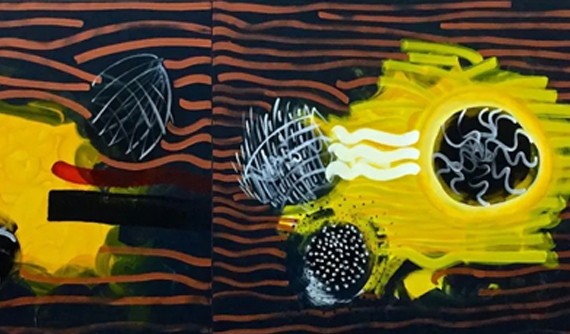With his extremely orderly, organic, and minimalist ink language, Zhang Zhaohui has become an independent force to be reckoned with in the field of contemporary Chinese ink wash. After graduating from the Department of History of Nankai University with a degree in Museum Studies in 1988, Zhang Zhaohui worked at the National Art Museum of China, then went to the United States to study curatorial program at Bard College in New York, and later separately studied for his MFA and PhD at the Chinese National Academy of Arts and the Central Academy of Fine Arts. His diverse artistic training and professional experiences have prompted him to break through the form of expression of traditional ink wash, and to place ink wash medium in a contemporary context to make new extracts and fusions. In his latest ink wash paintings, Zhang Zhaohui investigates "light", "space", and "the relationship between color and ink". In the first half of this year, his three ink wash paintings (2021) were exhibited and collected in a group show at the Fukuoka Asian Art Museum in Japan and the 29th Asian Art Exhibition at the Kyushu Geibunkan Museum in Japan.
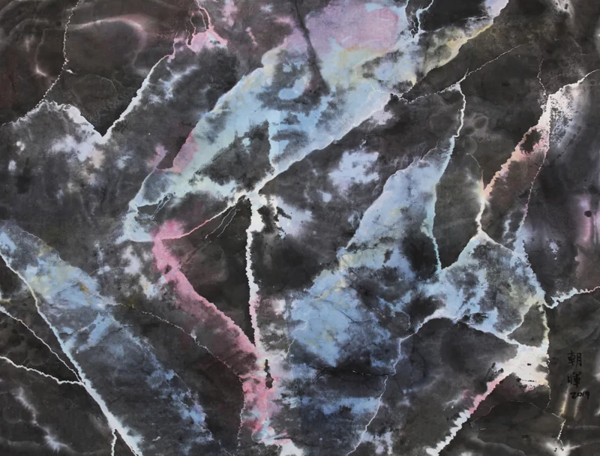
Zhang Zhaohui, Color Ink Series, 2019-2021, Ink and colour on rice paper, 180×130cm. Courtesy of Zhang Zhaohui
Hu Lingyuan: Talk about your 2020, you were in New York, did you mainly come to see the exhibition?
Zhang Zhaohui: Yes, I came over to see JUDD's solo exhibition at MoMA, because I had never been seen these colored and translucent works before. After seeing the original works, the spatial colors formed by the refraction and light penetration between the materials made me realize that the subjectivity and imagination of color can stimulate people infinitely inspiration. One will touch a different kind of attraction and allure when viewing these works from different angles and is affected by the environment of the gallery, such as the movement of the audience. This is completely different from the visual psychology of both rationality and independence, but also cold and hard, that was created by looking at his works before. Through the relationship between color and material composition light, this time, I realize that there is something sensual in his works. From an artistic point of view, one's intuitive sensibility is attracted to structure, space, and light, which is not from a poetic sense, but from a kind of existence composed of the interweaving of color, space, and light. This existence is emanating from the artist's spiritual world, which is full of high-class and unusual.
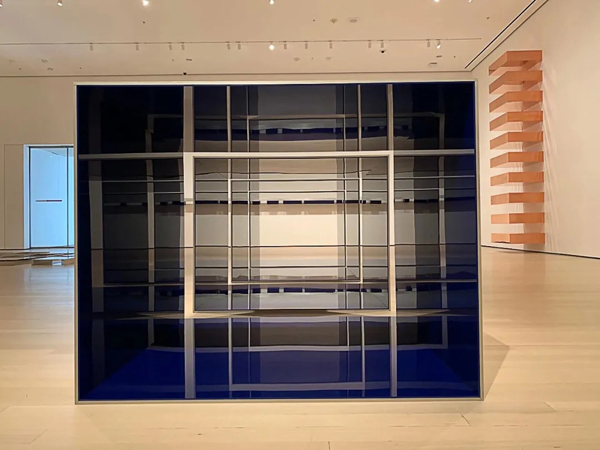
Donald Judd’s solo exhibition at MoMA, photographed by Zhang Zhaohui
Hu Lingyuan: We also rarely detect a sensual aspect of your works. Ink wash presents a sense of being disciplined under your brush. This visual presentation is different from traditional ink wash. So how do you master its uncontrollability?
Zhang Zhaohui: It is hard to say whether it is rational or sensual in art. Art creation is a random and accidental process in which the creator intertwines reason and sensibility to form an accurate grasp of intuition. I am a sensual person, so I need a reason to moderate and balance, rather than a profligate expression of self-feeling. In the New York art scene of the 1960s, the abstract expressionist artists showed unrestrained "promiscuity", followed by a group of minimalist artists who went to the other extreme. My artistic development has probably cycled between the two extremes. Compared to oil painting, ink wash is very fluid. Traditional ink wash painting painters can play with the characteristics of freehand brush work (Xieyi) at will. But even in the case of ink wash painting with great freehand style, outstanding ink artists still know how to restrain and control. They can grasp the advanced and subtle aspects of ink wash through long-term practice and personality cultivation. Thus, in my prior ink paintings, I focused on the self-discipline and restraint of brush and ink to endow ink wash with a rational color. Ink wash theorist Mr. Liu Xiaochun also emphasized the importance of brush and ink during his lifetime and hoped that today's ink painters would sublimate and transform traditional brush and ink into a contemporary brush and ink language. Based on that, he considered my transformation of brush and ink to be a rare example of success.
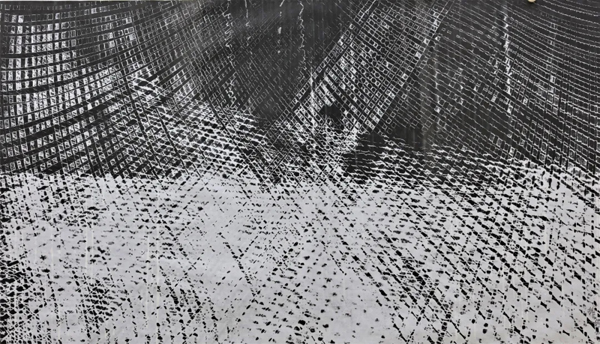
Zhang Zhaohui, Black and White Series, 2021, ink on rice paper, 140x180cm. Courtesy of Zhang Zhaohui
The raw nature and creativity of ink wash probably lead some people who have not been trained in the aesthetic and academic research system to take it as a nature. In terms of philosophical art, water follows the laws of nature – high and low or gravity flow – and the laws of physics. Therefore, I think that ink wash could have another nature, which is rational. I want to care for ink wash with the help of the light of reason developed in the context of modern civilization and let ink wash find another outlet.
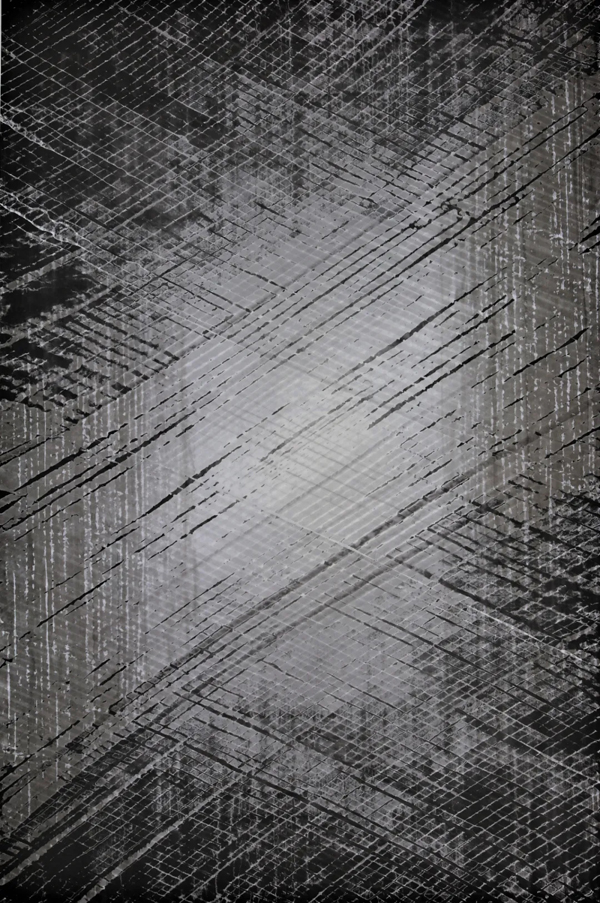
Zhang Zhaohui, Black and White, 2021, ink on rice paper, 179×97cm. Courtesy of Zhang Zhaohui
Hu Lingyuan: When you were an intern at the Asia Society Art Museum in 1997, you discussed the inclusion of ink was paintings in the show, Inside /Out: New Chinese Art. So, at that point in time, did you have a clear sense of direction for ink wash? Tell us what was the situation at that time?
Zhang Zhaohui: I was thinking about it in terms of the historical development of art; It would also have been a pity for me if these ink artists, such as Zhang Yu, Liu Zijian, and Yan Binghui, had not been included in the show. Before being 10 years old, I had a great passion for ink wash painting and drawing from Qi Baishi’s paintings and the Manual of the Mustard Seed Garden. When I was a junior high school student, I often went to the Forbidden City to see paintings, and later learned art history, including studying in the United States. I still consider that the ink wash painting was abundant with aura and a vibrant breath of life in my heart. But the modern and experimental ink wash in the period of New Wave 85 did not impress me because there was a deliberate attempt to create the illusion of modernity. From a certain point of view, the ink wash art of that time lacked the accumulation and care of the concept and consciousness of modern civilization. In this way, local artists could only transform ink wash as claimed by their superficial understanding of modern civilization, and thus its artistic feeling would be rather rough and rigid. But I think a steady constructiveness is the only way to revolt entirely.
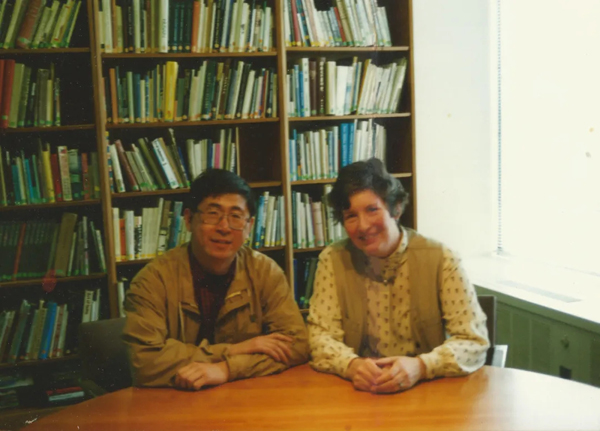
Zhang Zhaohui with Sarah Bradley, 1997. Courtesy of Zhang Zhaohui
In addition, during my studies in New York, I encountered some Western modern and contemporary artists and found that they had recreated and transformed some of their traditional mediums or aesthetic forms to burst forth with a modern aesthetic. This inspired me to think about ink wash. Ink, as an objective material, has been passed down for a thousand years, and many of the elements inside it can be converted into a contemporary art expression. Therefore, in my opinion, if contemporary art that is shared by the world is to emerge from the Chinese cultural context, ink wash should be an inevitable option. In the twenty years since my return to China, ink wash innovation has indeed become a key contemporary art section with great potential for development.
Hu Lingyuan: In August, your ink wash painting was exhibited in the 29th Asian International Art Exhibition which is known as the "Asian Games in the art world" held by Kyushu Geibunkan Museum. This is the third time your art has entered Japan. Were you invited by the curator? What is the difference between this exhibition and the previous ones?
Zhang Zhaohui: The biggest difference of this exhibition is that there are about ten Chinese ink artists participating. I was invited by Mr. Koichi Yasunaga of the organizing committee. My art has a strong connection with Fukuoka, Japan. In the early days of drawing ink wash painting, an old Japanese sculptor came to visit my studio in 798 and particularly liked the landscapes I painted. Then he said, "your paintings appear the modern oriental art I hope for," and compared my paintings with the artist Higashiyama Kaii, whom I extraordinarily admired as a child. Later, he recommended my ink wash paintings to Mr. Koichi Yasunaga, the director of the Fukuoka Asian Art Museum, which led to my first overseas solo exhibition, "Mountain and Water" (2014). Mr. Koichi Yasunaga expressed at that time, "your works can go out of China and out of Asia". Later, the museum collected some of the works from this solo show. Surprisingly, the certificate for the collection was issued by the mayor of Fukuoka, not only for the museum's collection but also as a cultural property of Fukuoka City.
Hu Lingyuan: That's a very high evaluation and affirmation.
Zhang Zhaohui: (laughs) I uphold an attitude of opening and absolute freedom towards ink wash because art creation is the freest thing in the world. Keeping pure openness and freedom under the established conditions is also the value and meaning of art's existence. Only the freedom of the mind can allow the works to convey infinite free possibilities.
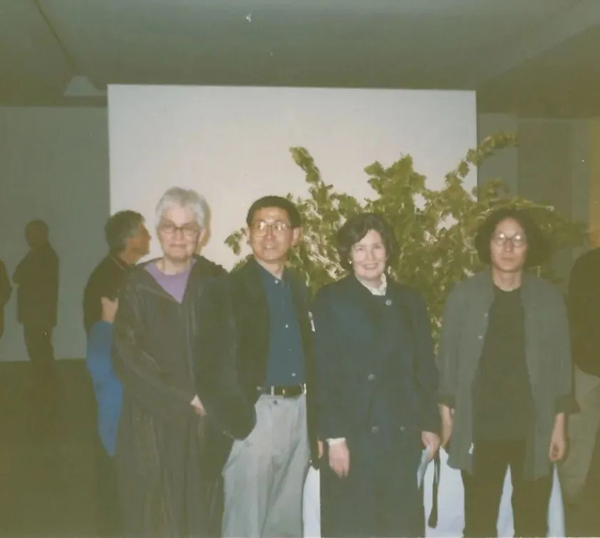
Opening reception of Zhang Zhaohui's graduation exhibition, Bard College Museum of Art, 1998, from right to left: Xu Bing, Sarah Bradley (Director of the Asian Cultural Council Arts Program), Zhang Zhaohui, Alison Knowles (a founding member of the Fluxus and Zhang Zhaohui's landlord). Courtesy of Zhang Zhaohui
Hu Lingyuan: Do you think these attitudes and thoughts have anything to do with the environment you grew up in?
Zhang Zhaohui: I believe so. They are related to my childhood living in a military compound, where a strict hierarchical living environment formed a rebellious character and at the same time created a desire for freedom. This kind of life in the compound during the late Cultural Revolution was partly shown in the movie "In the Heart of the Sun (1994)". Yet, I was not as mischievous as the children in the movie. I grew up loving art and wanted to follow my own heart to grasp the future. There were many senior intellectuals, old Red Army soldiers, generals, etc. residing in the compound. They all like to draw and write, and regularly hold some literary salons. Qi Gong and Zhao Puchu were often invited to the compound for PEN (Bi Hui). I enjoy this kind of literary salon in the troop compound, which was a unique presence for me at that time. Therefore, I was inculcated by going to it often.
Hu Lingyuan: What is the reason for changing the exhibited work from “Black and White Series” (2019) to “Light Infinite” (2016) in the 29th Asian International Art Exhibition?
Zhang Zhaohui: I reckon that it was decided by the curatorial committee. Yet, this is also a better arrangement, which can avoid repetition. because, in June, the “Black and White Series” was exhibited at the International Calligraphy and Painting Exhibition held by Fukuoka Asian Art Museum. This series is developed from the Light and Line series of the previous years, in which the light is diminished to highlight the contrast between black and white. But the sense of space is kept, while the lines are presented differently, more like the lines in ancient stone carving topiaries. The picture is abstract. Now it seems that incorporating the visual language or aesthetic feeling from traditional art into my abstract art creation is a characteristic of my ink art. Probably it is related to my study of art history and museology. And the “Light Infinite” can represent the coherence and continuity of my artistic development. It is closer to the work created in 2014, which is an advanced version of the light series, weakening the light and highlighting the texture of the ink material. When standing at a distance, one will discover that this painting looks like a dark gray flat abstract work. However, when looking closely, one notices that it is a kind of dense white space effect woven by horizontal and vertical lines of ink, like tiny points of light flickering and pulsating. This is what I detect more interesting.
Hu Lingyuan: No doubt that people who are familiar with your works can feel the presented artistic development. From my perspective, the contrast between line and light, black and white in the Black and White Series constitutes a three-dimensional space and imagination, which makes me feel a sense of science fiction or architecture.
Zhaohui Zhang: Actually, many people who are not particularly familiar with Chinese culture consider that my works are full of mystery and uncertainty. This may be connected to my cultural background and upbringing. I have bought a lot of architecture books, and I like to see the exterior of buildings when I go to museums. Besides that, I like to observe the growth of natural creatures, because the wonderful and powerful life itself is very touching. In the courtyard where my studio is now located, I raised some chickens, cats, and dogs, whose growth process is interdependent and similar to human life. All these are hidden in my consciousness, and I hope that my works are the process of natural growth too. I always believe that artists should feel the world with their intuition and convey their grasp of the confusing and unknown world. In this way, art can have the same value as science, philosophy, and religion. But I won’t pay that much attention to it when creating. Each series is created by different approaches. I prefer to make different attempts, maybe failing at the end, or succeeding in developing new language expressions, but they are all derived from my ink spectrum. This process is open.
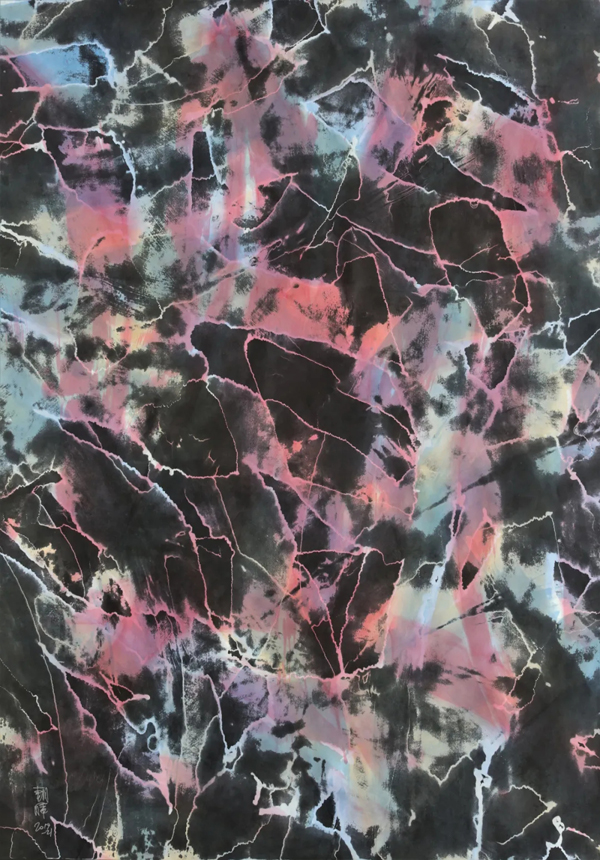
Zhang Zhaohui, Color Ink Series, 2019-2021, Ink and colour on rice paper, 179×131cm. Courtesy of Zhang Zhaohui
Hu Lingyuan: Tell us about your ink wash works in color, which is related to the “Black and White Series”?
Zhang Zhaohui: The two series developed simultaneously, and both matured gradually after more than three years of explorations. As to a sensual viewpoint, I wanted to maintain the purity of ink wash, but at the same time, I also suppressed the expression of color itself. I recall when I first exhibited color works at the Red Gate Gallery, people showed a little puzzled, then I joked, "I want to show you some color (laughs). The “Color Series” is the result of studying the relationship between color and ink. Color plays an extremely role in the history of Western painting, and there are countless masters of color, such as Rembrandt, Titian, Velasquez, and many artists whose colors are still very impressive until the present day. However, the history of Chinese painting seems to have very rare works that impress people with color, only a few artists such as Lin Fengmian and Wu Guanzhong. The traditional ink wash format seems to highlight the brushwork and ink technique of ink wash while ignoring color. Until now, the color in ink wash has remained within the scope of " Colors Application (following a different kind of subjects) ", and the independent aesthetic value of color has been annihilated and dormant. Therefore, I would like to transplant Western color science, such as chromaticity, chroma, and hue, into the system of ink wash, and become a new graft. Although the color resources within ink painting are relatively poor, the traditional material culture outside of ink painting can be distilled and has its own referenced color system, such as the red walls, golden bricks, and blue tiles of the imperial palace in Beijing. They are particularly beautiful against the blue sky and white clouds, the so-called "golden splendor". There are also colorful minority costumes in folk art, blue and white porcelain, various jade, etc., which have the beauty of pure and noble as well as roundness as pearl. These are distinct from the color aesthetics of other civilizations and have a particular texture that reflects the uniqueness of the roots of culture. Therefore, how to refine and transform them into my ink wash painting is also the direction I have been thinking and exploring.
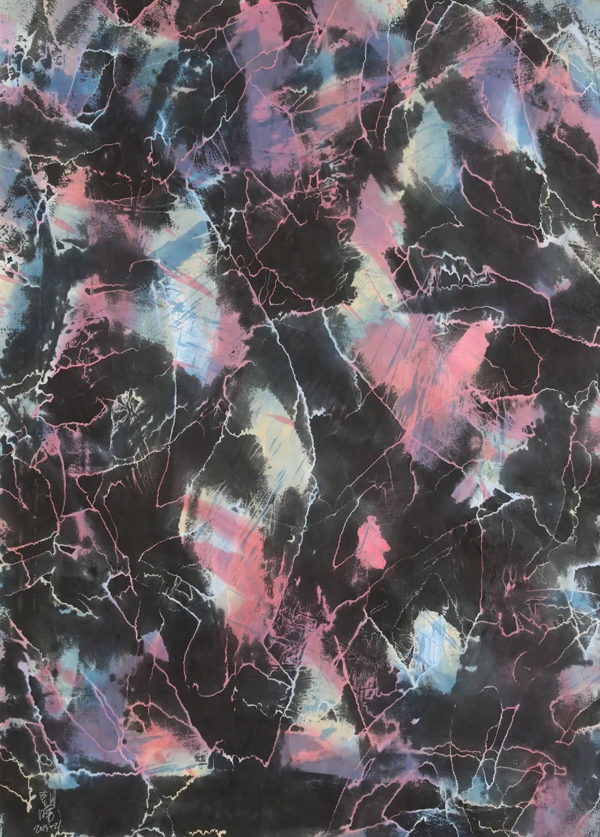
Zhang Zhaohui, Color Ink Series, 2019-2021, Ink and colour on rice paper, 180×130cm. Courtesy of Zhang Zhaohui
Hu Lingyuan: So, you keep thinking about and digging into the traditional Chinese culture on the inner level of color.
Zhang Zhaohui: Absolutely, but this also has to do with seeing JUDD's solo exhibition. His precise grasp of the colorfulness of objects and utilization of the color and the interrelationship of the two points really touched my feelings. The colorfulness of objects and the texture of objects to a certain extreme is the artistic power itself. Therefore, in my paintings, color is color, and ink is ink. I would like to let them play naturally and reflect on each other, which makes the “Color Series” its characteristics.
Hu Lingyuan: These two series are a continuation of the previous series and form another transformation. How do you understand this change?
Zhang Zhaohui: I don't pre-determine any rules and regulations for myself. I just go with the flow. In the past ten years or so, I have explored various possibilities of ink wash development. On the one hand, I studied various art histories and theories before my forties; on the other hand, I observed masterpieces in art museums around the world, so I had a solid art foundation. Therefore, when I entered the field of art creation, I was able to keep open and play freely. I used my intuition to feel the world and construct my art. Thus, for my artistic exploration, I do not limit myself to ink wash but wish to use the international cultural landscape as my artistic thinking and creative background. After all, life is constantly evolving and developing, and cultural genes will not be stagnant and frozen, and the same goes for ink art.
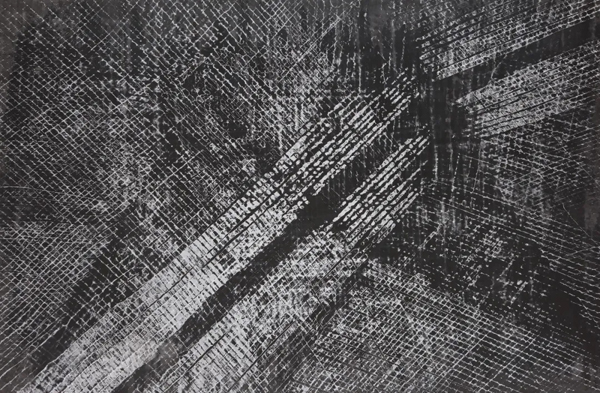
Zhang Zhaohui, Black and White, 2021, ink on rice paper, 97×179cm. Courtesy of Zhang Zhaohui
Hu Lingyuan: "Light" also has different functional expressions in this transformation, such as the sense of flowing light after mirror refraction, or the meaning of white space in literati painting. How do you define its expression in your future works?
Zhang Zhaohui: The “light” was discovered occasionally, and simultaneously I thought there was a huge space, as a result, it became the core theme. The spatial weave and structure of the ink wash lines present the feeling and expressiveness of light, and I was very much addicted to the sense of infiltration and luster that it showed. And the grayscale of the ink showed its unique aesthetic, seemingly unrelated to ink wash but strongly expressive and infectious. In those years, there were more international masters about light art and the creation of light. Take Anish Kapoor as an example who mirrored the light with the industrial materials. The “light” also dates to my early performance art “Mirror Man”. However, it will not be merely a significant theme in my work. I will gradually shift my attention from light to other directions, such as doing pure black and white, color, and abstract works. This is because I have a desire to keep moving towards the unknown, to be curious about the future, and to turn it into an artistic reality.
Hu Lingyuan: Through ink wash, what do you want to bring to the art appreciators?
Zhang Zhaohui: My exploration of ink wash is about constantly discovering itself. With the help of ink and brush, I intend to accomplish its natural appearance and then bring something to the viewers that they have not yet perceived or realized, such as the overlapping part of nature and freedom, and the subtle relationship between the two, the commonality of people's perceptions, and more. These have always been the direction of my thinking and concern for artistic expression.


